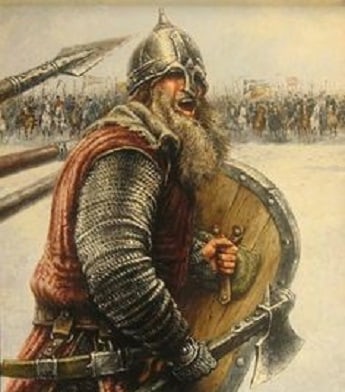Who were the Vikings
The Vikings were ancient Scandinavian people (Norse) who lived in Norway, Denmark, and Sweden in the Middle Ages, from approximately 793 AD to the early 11th century. These medieval Norsemen terrorized Europe for over 250 years.On this page we discuss who the Vikings were, where they lived, how they became so successful, and several other aspects of their history. For more detailed information on many aspects of Viking life see the other pages of this site. This information is written for both kids and adults.
Click here for a great selection of Amazon.com books about the Vikings.The popular picture of Vikings as merciless, savage warriors is somewhat distorted. This was certainly part of the Vikings history but not the only part. They were amazing mariners and explorers, and archeological sources tell us they were mainly farmers and traders.
Most historians mark the beginning of the "Viking Age" as June 8th 793 A.D. when the Vikings looted and burned a church and convent on an island off the east coast of England called Lindisfarne. The raid on Lindisfarne was to become typical of how the ancient Norse warriors would conduct their early attacks. It was quick, it was a surprise, they attacked a target close to the shore, the objective was looting, and they left quickly.
Viking history is closely connected to the sea. They are well known for their costal attacks, sea expeditions, and sea trade routes. In fact the word Viking probably originates from the Swedish word for bay "vik". The Vikings used long narrow boats that could be powered by sail or oar. These so called long ships were quick, light, and could be sailed right onto a beach making Viking attacks lightning quick. The Vikings became some of the most famed sailors in history so confident in their skills that they even reached, and settled in North America for a brief time.
Viking Religion
The ancient Norse people had a polytheistic religion which means they believed in more than one god. These gods included the chief god Odin and his famous son Thor. Upon death the Vikings believed a person ended up in one of several places. These places included Valhalla, reserved for warriors who died bravely in battle, and Hel for those less fortunate.Norwegian Vikings and Swedish Vikings
Historians usually make a distinction between "Danish/Norwegian" and "Swedish" Vikings. The "Danish/Norwegian" Vikings were know for concentrating their voyages in western Europe, including England, Ireland, and Scotland. They ventured as far as Iceland, Greenland, and even North America. They settled Iceland in 874 and visited Greenland in 876, 616 years before Columbus sailed to America. Their greatest feat was sailing to North America. This was accomplished by Leif Ericsson in the year 1000. Eventually they set up settlements in L'Anse aux Meadows, Newfoundland and Labrador Canada.
The Swedish Vikings concentrated mostly on eastern Europe reaching such places as modern-day Russia. The Vikings settled in a Russian town called Novgorod, which they called "Holmgard". It has been argued that the Swedish Vikings founded Russia. This is not very likely. However the name Russia is probably derived from the name of the Swedish Viking "Ruser".
What Happened to The Vikings
Most historians mark the end of Viking history to be in the early 11th century. This was not a sudden event, like the loss of a great war. The end of the Viking Age was a gradual process and below is a list of factors that contributed to this.- One of the main factors is that towards the end of the Vikings history strong nations formed in Europe under strong kings. These nations organized armies that could defend against Viking raids.
- Another major factor was the coming of Christianity as the main religion in Scandinavia. The Christian church believed Christians should not enslave fellow Christians. This removed much of the economic incentive for conducting raids. Many Norse people willingly adopted this new religion where as others were forced to convert by their rulers.
- Overtime the Norse people just became part of the strong large nations that were formed in Scandinavia.
Viking History Time Line
- 793 The monastery of St. Cuthbert at Lindisfarne is attacked by the Vikings
- 844 Vikings raid Seville in Spain
- 845 Vikings raiders travel up the River Seine in France. They are led by Ragnor
- 845 In order to prevent the sacking of Paris the French King pays a ransom
- 860 Vikings attack Constantinople
- 862 Vikings found the Russian city of Novgorod
- 874 Vikings settle Iceland
- 900 Vikings conduct several raids along the Mediterranean coasts
- 911 Under Rollo the Vikings settle in Normandy
- 981 Greenland is discovered by Erik the Red
- 986 Vikings land in Canada
- 1000 Vikings convert Greenland and Iceland to Christianity
- 1000 Leif Eriksson sails to the American coast
- 1042 Edward the Confessor regains the throne of England
- 1050 The city of Oslo in Norway is established by the Vikings
